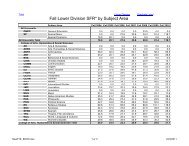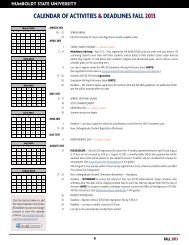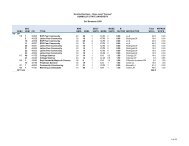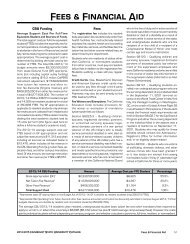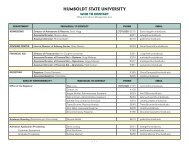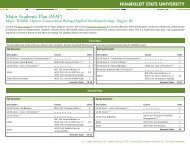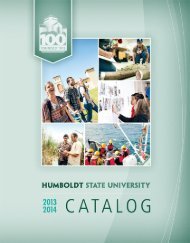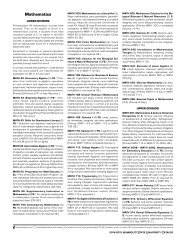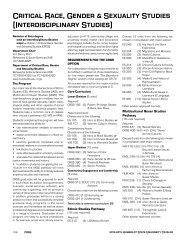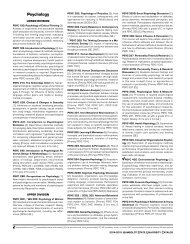2007-08 Academic Year - Humboldt State University
2007-08 Academic Year - Humboldt State University
2007-08 Academic Year - Humboldt State University
You also want an ePaper? Increase the reach of your titles
YUMPU automatically turns print PDFs into web optimized ePapers that Google loves.
FISH 585. Ecology of Running Waters (3). Characterization<br />
of the physical and chemical environment,<br />
adaptations, distribution, and interactions of<br />
riverine biota, ecosystem structure and dynamics,<br />
and response to human alteration. [Prereq: BIOL<br />
330 or any upper division ecology class.]<br />
FISH 597. Mentoring & Teaching Associate<br />
Training (1-4). Train in course preparation and delivery.<br />
[CR/NC. Advanced majors or grad students<br />
take prior to, or concurrent with, assignments as<br />
teaching assistants/associates.]<br />
FISH 685. Graduate Fisheries Seminar (1). Discuss<br />
and review advanced topics. [Prereq: grad<br />
standing. CR/NC. Rep.]<br />
FISH 690. Thesis (1-4). [Prereq: grad standing.<br />
Rep.]<br />
FISH 695. Research Problems in Fisheries<br />
(1-4). Individual research on advanced lab or field<br />
problems. [Prereq: grad standing. Rep.]<br />
FISH 699. Directed Study (1-4). Advanced independent<br />
studies terminating in tangible evidence<br />
of academic accomplishment. [Prereq: grad<br />
standing. Rep.]<br />
Forestry<br />
LOWER DIVISION<br />
FOR 100. Critical Thinking and Social and<br />
Environmental Responsibility (3). How to think<br />
critically. Argument identification and evaluation.<br />
Formal and informal fallacies. The use of critical<br />
thinking methods with application to questions of<br />
environmental and social responsibility. Limited to<br />
undergraduate. [GE.]<br />
FOR 100R. Critical Thinking and Social and<br />
Environmental Responsibility (3). How to think<br />
critically. Argument identification and evaluation.<br />
Formal and informal fallacies. The use of critical<br />
thinking methods with application to questions of<br />
environmental and social responsibility. Limited<br />
to undergraduate. For <strong>Humboldt</strong> Connections<br />
cohort. [GE.]<br />
FOR 116. The Forest Environment (4). The<br />
forest and its complexity. Identify trees, plant<br />
communities, and wildlife and understand their<br />
interdependence. Multicultural perspectives of historical<br />
and topical conservation issues. Role and<br />
ethical responsibilities of the forester. [Weekly: 2<br />
hrs lect, 1 hr disc, 3 hrs lab.]<br />
FOR 150. Logging Conference Field Trip (1).<br />
Field trip to regional logging conference to observe<br />
professional demonstrations of forest operations<br />
equipment and to hear presentations by experts<br />
in forest management operations. Does not count<br />
towards forestry major. [Rep. CR/NC.]<br />
FOR 170. Conclave: Logging Sports Competition<br />
(1). Local or regional logging sports competition.<br />
Safe use of traditional and modern forest<br />
operations equipment. Does not count towards<br />
forestry major. [Rep. CR/NC.]<br />
FOR 210. Forest Measurements (4). Forest<br />
engineering, public land survey, distance direction,<br />
and elevation measuring; topographic map<br />
reading and construction; log scaling and tree<br />
measurements under field conditions. [Weekly: 2<br />
hrs lect, 1 hr disc, 3 hrs lab.]<br />
FOR 216. Forest Remote Sensing & Geographic<br />
Information Systems (4). Use aerial photographs<br />
and satellite imagery to interpret, recognize, and<br />
delineate forest types, land management practice,<br />
wildlife habitat, and other significant environmental<br />
parameters. Map and spatially analyze<br />
these landscape features using computerized<br />
geographic information systems (GIS). [Weekly:<br />
3 hrs lect, 3 hrs lab.]<br />
FOR 220. Forest Resource Protection (4).<br />
Management of forests for sustained health and<br />
productivity. Effects and symptomatic identification<br />
of biotic and abiotic forest disturbance agents.<br />
Silvicultural strategies for increasing resistance<br />
and decreasing susceptibility to damage. [Prereq:<br />
FOR 116, FOR 230 (C) or IA. Weekly: 3 hrs lect,<br />
3 hrs lab.]<br />
FOR 230. Dendrology (3). US trees/shrubs.<br />
Ranges, botanical characteristics, commercial and<br />
noncommercial uses, growth rates, and relation<br />
of plants to their total environment. Identify under<br />
field conditions and using herbarium specimens.<br />
[Weekly: 2 hrs lect, 3 hrs lab.]<br />
FOR 231. Forest Ecology (3). Ecological principles<br />
applied to forest management. Production ecology,<br />
biogeochemistry, disturbances, environmental<br />
factors, populations, community ecology, forest<br />
succession, and forest classification/description.<br />
[Weekly: 2 hrs lect, 3 hrs lab.]<br />
UPPER DIVISION<br />
FOR 302. Forest Ecosystems & People (3).<br />
Interaction between forest science principles of<br />
different forest ecosystems and social expectations<br />
and needs. Evolution of how people use the<br />
forests of California, from wilderness to city parks.<br />
California as the leading edge of forest users.<br />
Nonmajors only. [GE.]<br />
FOR 307. California’s Forests & Woodlands<br />
(3). Factors affecting distribution, perpetuation,<br />
and health of California’s forests and woodlands.<br />
Field identification of northern California trees<br />
and shrubs. [Prereq: completed area B lower<br />
division GE. Weekly: 2 hrs lect, weekend field trips<br />
in northern California. GE.]<br />
FOR 311. Forest Mensuration & Growth (4).<br />
Sampling techniques in forest inventory, timber<br />
cruising, and site index determination. Develop<br />
volume tables and predict stand growth. Use<br />
growth models and computer applications.<br />
[Prereq: FOR 210, 230 (C); BIOM 109. Weekly:<br />
3 hrs lect, 3 hrs lab.]<br />
FOR 313. Forest Land Surveying (3). Direct<br />
and indirect leveling, solar observation, transit<br />
traverse, public land survey, triangulation. Plot<br />
and draft field data; determine areas; read and<br />
construct topographic maps. [Prereq: computer<br />
skills, FOR 210. Weekly: 2 hrs lect, 3 hrs lab.]<br />
FOR 315. Forest Management (3). Managing<br />
forest-covered landscapes to meet a variety of<br />
objectives by applying economic, sociological,<br />
ecological, silvicultural, and operational principles.<br />
Nonmajors only. [Weekly: 2 hrs lect, 3 hrs lab.]<br />
FOR 321. Fire Ecology (3). Fire as an ecosystem<br />
and physical process. Fire history, fire effects,<br />
fire regimes; interactions with abiotic and biotic<br />
ecosystem components; managing fire in California<br />
bioregions. [Prereq: Course in Ecology or IA.<br />
Weekly: 2 hrs lect, 3 hrs lab.]<br />
FOR 323. Fire Behavior / Suppression (3). Effects<br />
of weather, topography, and fuels on fire behavior.<br />
Fire effects on fuels and smoke. Fire behavior<br />
models, prevention, suppression planning, control<br />
tactics, incident command system, wildland fire situation<br />
analysis. [Prereq: FOR 220 (C) or IA.]<br />
FOR 331. Silvics—Foundation of Silviculture<br />
(4). Woody plant interaction with environmental<br />
stresses. Factors influencing vigor and growth.<br />
Changes to stand structure caused by humans<br />
(thinning, harvesting, fertilization), nature (wind,<br />
soil, climate) or time. Selection using genetic principles<br />
for improved growth. Seedling production<br />
methods in stock types in relation to their effect<br />
on morphology/survival. [Prereq: FOR 231, BIOM<br />
109, SOIL 260. Weekly: 3 hrs lect, 3 hrs lab.]<br />
FOR 333. Forest Tree Improvement (3). Principles/practices<br />
of tree improvement. Obtaining<br />
genetically better trees for forest reproduction.<br />
Prereq: FOR 331, BIOM 109. Weekly: 2 hrs lect,<br />
3 hrs lab.<br />
FOR 343. Forest Road Location & Design<br />
(3). Road design procedures, standards, and<br />
techniques for forest management. Reconnaissance,<br />
route surveying, office and field design and<br />
location, geometrics, drainage systems, soil engineering,<br />
construction sequencing and techniques,<br />
erosion control, maintenance. [Prereq: FOR 216,<br />
SOIL 260. Weekly: 2 hrs lect, 3 hrs lab.]<br />
FOR 350. Forest Harvesting & Utilization<br />
(4). Harvesting systems and methods, including<br />
operating characteristics and environmental<br />
impacts. Wood anatomy, utility, and processing.<br />
Wood as biological material and structural member.<br />
[Prereq: FOR 210, 216, 231. Weekly: 3 hrs<br />
lect, 3 hrs lab.]<br />
FOR 365. Financial Forest Administration<br />
(4). Capital budgeting; benefit/cost analysis; forest<br />
appraisal and taxation; welfare economics,<br />
management decision making; uncertainty and<br />
risk. [Prereq: FOR 311 (C). Weekly: 3 hrs lect,<br />
3 hrs lab.]<br />
FOR 374. Wilderness Area Management (3).<br />
Paradox of “managing” wilderness; scientific, legislative,<br />
philosophical frameworks; managing human<br />
use of, and influences on, wilderness. [Weekly: 2<br />
hrs lect; weekend field trips.]<br />
FOR 400. Forestry in Modern Society (3). “Humans<br />
are moral creatures” as a model for human<br />
integration. Role of professional forestry to serve<br />
society and conserve the landscape. Social and<br />
environmental reasoning for integrating layers<br />
of moral obligation. [GE.]<br />
FOR 422. Wildland Fire Use (3). Applying prescribed<br />
fire in land management. Fire effects,<br />
prescription burning objective, benefits, plans,<br />
prescriptions, firing patterns, burn monitoring and<br />
evaluation, and smoke management. [Prereq: FOR<br />
321 and FOR 323, or IA. Evening presentations<br />
activ activity; (C) may be concurrent; CAN California articulation number; coreq corequisite(s); CR/NC mandatory credit/no credit; CWT communication & ways of thinking; DA dept approval<br />
212 Fisheries<br />
<strong>2007</strong>-20<strong>08</strong> <strong>Humboldt</strong> <strong>State</strong> <strong>University</strong> Catalog



